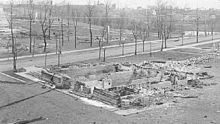| Cloquet Fire | |
|---|---|
 | |
| Date(s) | October 12, 1918 8:00 am |
| Location | Carlton County, Minnesota, United States |
| Statistics | |
| Burned area | 250,000 acres (1,000 km2) |
| Land use | Mixed use |
| Impacts | |
| Deaths | 453[1] |
| Non-fatal injuries | ≈ 52,000 |
| Damage | $72 million ($1.42 billion adjusted for inflation) |
| Ignition | |
| Cause | Sparks from train |
The Cloquet Fire (/kloʊˈkeɪ/ kloh-KAY)[2] was an immense forest fire in northern Minnesota, United States in October 1918, caused by sparks on the local railroads amid dry conditions. The fire left much of western Carlton County devastated, mostly affecting Moose Lake, Cloquet, and Kettle River. Cloquet was hardest hit by the fires; it was the worst natural disaster in Minnesota history in terms of the number of casualties in a single day. It is also the third-deadliest wildfire in recorded history, behind the Peshtigo fire of 1871 and a 1936 wildfire that occurred in Kursha-2.
In total, 453 people died[1] and 52,000 people were injured or displaced. Thirty-eight communities were destroyed, with 250,000 acres (100,000 ha) burned, and $73 million ($1.479 billion in 2024 United States dollars) in property damage; $13 million in federal aid was disbursed.
- ^ a b Rogers, Paul (22 November 2018). "Camp Fire is deadliest U.S. wildfire in 100 years; eerily similar to 1918 inferno that killed 453". East Bay Times. Retrieved 25 November 2018.
- ^ "Minnesota Pronunciation Guide". Associated Press. Archived from the original on July 22, 2011. Retrieved July 4, 2011.